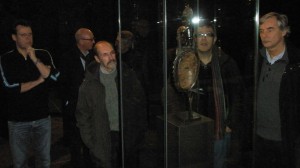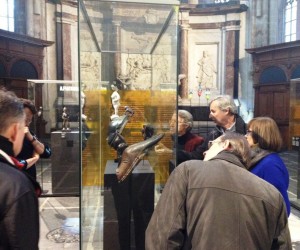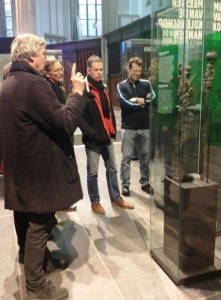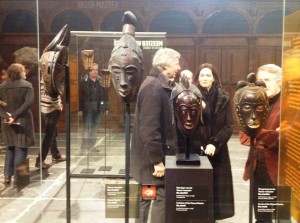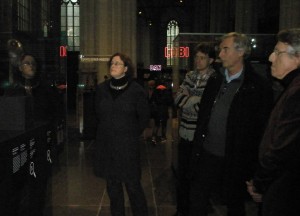Author Archives: hans
Milwaukee Public Museum
Bruno Claessens: Field-photo of Phuonchu Aseh’s workshop in Babanki-Tungo (Cameroon), 2015
I recently discovered this incredible field-photo of a famous Cameroon sculptor-king at work. Phonchu Aseh (also written Phuonchu Aseh, Fontshue Ase, Fo Ntshue and Fonchu) became king after the dead of his father Aséh Yufanyi – who was also a sculptor – and reigned in Babanki-Tungo (in the Cameroon Grassfields) until his death in 1918/19. In 1913, the Catholic missionary Johannes Emonts visited him – giving a detailed account of his artworks and sculpting technique in his book Ins Steppen und Bergland Innerkameruns (1927). The foyn (or king) stated that he had learned to sculpt from his father. At first he was specialized in anthropomorphic and zoomorphic (elephant & bird) masks, an old tradition in the region. After admiring the royal thrones in Bamun, he decided to devote himself to the carving of thrones and stools and limited himself to a royal clientele. His reputation quickly grew to such a point that most of the neighboring royal treasuries possessed at least one of his works. Also in further away kingdoms (like Bagam, Nkambé, Fontem, Bafut and Bamun) his work could be found (this wide distribution of works in the Babanki-Tungo style would later become the source of much confusion on the part of researchers when attributing objects to a specific kingdom).
The above field-photo shows Phuonchu Aseh sculpting. On the right a prestige bed ordered by the Bamun king Njoya can be seen. Representatives of Njoya were present when Phuonchu solemnly finished the last details of the bed. Phuonchu would send the bed with a delegation to Bamun, 3-4 days walking from Babanki-Tungo, and in return received several wives from king Njoya. Strumpell collected a similar bed in Babanki-Tungo in 1905, illustrated below.
Typical for Phuonchu Aseh’s well-documented style are almond-shaped eyes embedded in broad eyelids, curved brows which are notched, the oval face narrowed to a point at the chin and unfiled teeth in a half-open mouth. Pierre Harter lists a throne acquired from the fon of Bagam in 1925 by father Christol (currently in the British Museum and illustrated below) as one of the best executed stools from Phuonchu Aseh.
Many of Phuonchu Aseh’s thrones are very alike. The majority of the examples in German museums however lack patina. They were never used and commissioned by German colonial officers. Furthermore, the quality of the thrones and stools is quite uneven since the sculptor-king often entrusted the execution of less important commissions to less skilled assistants.
Several magnificent palace posts are widely considered as the best work of this Phuonchu Aseh. The Ethnographic Museum in Geneva has two; both illustrate palace life: in one we recognize a chief with his insignia, a woman with a small child, and a notable; the other portrays two men and a leopard, with the same basic structure. Less cheerful is the scene represented on a third pillar in the Museum der Kulturen in Basel. The collection records contain the following information recorded by Hans Himmelheber – who brought the pillars back from Africa in 1937: ‘Pillar from the reception hall of the king of Babanki-Tungo, showing the hanging of a man who seduced one of the king’s wives’. The executioner’s heads are turned away from the viewer.
Museu Etnològic i de Cultures del Món-Montcada, Barcelona.
New Jersey: Newark Museum
23-01-2015: Bezoek aan het depot van het Tropenmuseum, Amsterdam
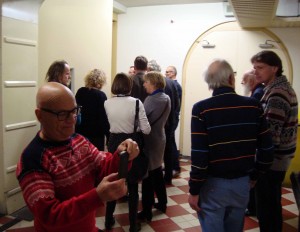 Vrijdag 23 januari 2015 staan 13 leden van onze vereniging vol verwachting in de entreehal van het Tropenmuseum te wachten. Met Koos van Brakel, hoofd collecties van het Nationaal Museum van Wereldculturen gaan we twee uren door het depot van het museum dwalen. We dalen af in de krochten van het museum, waar we eerst een uitleg krijgen over het ontstaan van de collectie. Oorspronkelijk was alles in Haarlem gevestigd, maar later is het verplaatst naar Amsterdam. Ook Artis had een collectie etnografica, want in navolging van de theorieën van Darwin, moesten exotische volken in het kader van de evolutie ook bestudeerd worden. Deze collectie is vervolgens overgeplaatst naar het Tropenmuseum. In deze collectie bevonden zich unieke stukken die door onderzoekers verzameld waren die soms als eerste blanken op een eiland kwamen. Om deze en nog een aantal andere redenen, is het museum in het bezit van een aantal unieke stukken.
Vrijdag 23 januari 2015 staan 13 leden van onze vereniging vol verwachting in de entreehal van het Tropenmuseum te wachten. Met Koos van Brakel, hoofd collecties van het Nationaal Museum van Wereldculturen gaan we twee uren door het depot van het museum dwalen. We dalen af in de krochten van het museum, waar we eerst een uitleg krijgen over het ontstaan van de collectie. Oorspronkelijk was alles in Haarlem gevestigd, maar later is het verplaatst naar Amsterdam. Ook Artis had een collectie etnografica, want in navolging van de theorieën van Darwin, moesten exotische volken in het kader van de evolutie ook bestudeerd worden. Deze collectie is vervolgens overgeplaatst naar het Tropenmuseum. In deze collectie bevonden zich unieke stukken die door onderzoekers verzameld waren die soms als eerste blanken op een eiland kwamen. Om deze en nog een aantal andere redenen, is het museum in het bezit van een aantal unieke stukken. 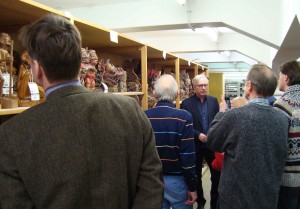
Denk niet dat het museum alleen oude stukken verzameld. Zo zijn een paar jaar geleden nog twee Papuaschilden gekocht, die nog met de oorspronkelijke intenties gemaakt zijn, maar toch een zekere ontwikkeling te zien geven. Ook dat wil het museum laten zien.
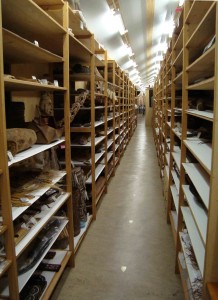 We hebben onze tijd doorgebracht in de afdelingen voor Aziatische kunst en cultuur, met uiteraard vooral veel uit Indonesië, en Oceanië, met veel uit Papua-Nieuw-Guinea. Al rondlopend vielen we soms van de ene verbazing in de andere. Kortom, het was een geweldig boeiende middag en we willen er graag nog eens terugkomen! Omdat er geen foto’s voor publicatie gemaakt mogen worden, ziet u hier maar een paar indrukken.
We hebben onze tijd doorgebracht in de afdelingen voor Aziatische kunst en cultuur, met uiteraard vooral veel uit Indonesië, en Oceanië, met veel uit Papua-Nieuw-Guinea. Al rondlopend vielen we soms van de ene verbazing in de andere. Kortom, het was een geweldig boeiende middag en we willen er graag nog eens terugkomen! Omdat er geen foto’s voor publicatie gemaakt mogen worden, ziet u hier maar een paar indrukken.
Hans Hamers
18-01-2015: bezoek aan de tentoonstelling Magisch Afrika, maskers en beelden uit Ivoorkust.
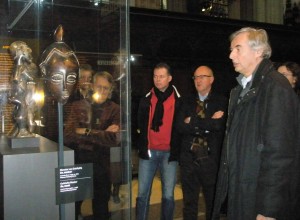 Op zondag 18 januari 2015 brachten 14 leden van de VVE een bezoek aan de tentoonstelling ‘Magisch Afrika, maskers en beelden uit Ivoorkust.De kunstenaars ontdekt.’ Ze kregen een rondleiding van Rutger der Kinderen.
Op zondag 18 januari 2015 brachten 14 leden van de VVE een bezoek aan de tentoonstelling ‘Magisch Afrika, maskers en beelden uit Ivoorkust.De kunstenaars ontdekt.’ Ze kregen een rondleiding van Rutger der Kinderen.
Rutger der Kinderen, lid van de VVE, is betrokken geweest bij de inrichting van deze mooie expositie. Een belangrijk stuk, lange tijd uit het zicht van de organisatoren van het Rietberg Museum uit Zurich, bleek bij hem thuis te staan en is nu in de Nieuwe kerk in Amsterdam te bewonderen.
Cleveland: Cleveland Museum of Art
Albert Stanziano: Diminutive Spirits. Passports and Masquettes from the collection of Albert Stanziano, 2013
Hieronder staat de inleiding op een tentoonstelling met miniaruur- en papoortmaskertjes. De maskertjes zijn op de website van het museum nog steeds te zien.
Diminutive Spirits. Passports and Masquettes from the collection of Albert Stanziano.
African Art Museum, Society of African Missions (SMA), Tenafly, New Jersey, USA
Exhibition from 2013. For the pictures click here
Introduction
In the western tradition, a mask is a covering for all or part of the face that is worn to conceal a person ’s identity. But for the indigenous peoples of Africa, a mask is the objective correlation of a spiritual force or power. It is not a representation of the spirit; it is a presentation of the iconic attributes of the spirit as imagined by the collective intellectual and emotional needs of a group of people sharing a physical, economic and political locus. But most African masks are made to be worn — to be danced in a performance that may be described as cosmic theater. They are large enough to conceal the face, head, neck and shoulders or even the whole body of the wearer. Some have integral gloves and slippers to cover the hands and feet. The masquerader is no longer himself, and he must not be recognized as a human being. He is the spirit, perceived as such as long as he wears the mask.
Masks that are too small to be worn fall into three categories: personal, miniature and family masks.
Personal masks do not replace the larger masks owned and worn by their owners. Rather, they are highly stylized portraits of the individual human being, or, to be more precise, of his unique psychological entity, imbued with the forces of a larger communal psyche.
Miniature masks may serve as repositories of the spiritual powers of larger masks that have been damaged or destroyed through use and over time. Once ‘materialized’ the power of a mask does not die; therefore, it must be dealt with by living human beings in one way or another. The miniature serves as a place of abode for that power.
Family masks are kept on the shrine in the compound. They protect all the members of the owner ’s extended family or clan.
Both personal and miniature masks may serve as guardians, protecting their owners from black magic and the danger of ‘nyama’, the huge collective force of the spirit world. The Bassa have both types and sometimes it is difficult to distinguish between the two.
Among the Dan and Mano a ‘ma’ or passport mask validates a man ’s right to commission, own and wear his own full-sized dance mask. In addition, because it is small enough to be worn or carried on his person, it guards him whenever and wherever he needs protection, from his initiation into the men ’s secret society until his death, through the whole of the physical, intellectual and emotional space of his adult life.
Many of the masks in this exhibition have a shiny surface that testifies to the touch of hands over long periods of time. Others carry accretions of sacrificial material on crusted surfaces or in power packs fastened to the surface by a variety of means — tied, glued, nailed.
It is with great pleasure — and I must admit, pride, that I share my treasures with the SMA African Art Museum and with you, the visitor to this exhibition. Most of the collection shown here was formed years ago, but I must admit I still rise to the bait of an extraordinary piece. I say ‘extraordinary’ for several reasons: I already have a good survey of mask types and styles in every possible medium; Good to great examples are becoming increasingly difficult to come by; Increased demand for passport, miniature and family masks has driven prices to unreasonable heights.
These wonderful objects are cherished and cared for by their African owners from generation to generation. Some are kept in sheepskin packets when not in use. At meetings of the Poro, a powerful men ’s secret society, they are placed on the ground to validate the right of the zoe to participate in meetings and rituals. For that reason they are popularly known as ‘passport masks’.
I extend warmest thanks to the American Province of the Society of African Missions for hosting ‘Diminutive Spirits’. To my friend and colleague Leonard Kahan, my mentor in the field of African art and consulting curator for this exhibition, I owe the pleasure of a shared enthusiasm for African art which has enriched my intellectual life for many years. I am grateful to him for bringing Robert J. Koenig, Director of the SMA AfricanArt Museum, to my home. When Bob saw my passport, miniature and family masks, he enthusiastically ojfered me an exhibition at the SMA African Art Museum.
Peter Cade has contributed his expertise to the installation of the exhibition and to the fine publications associated with it. Norman Mai, GBH Electric, and his assistant Dave, installed the state-of-the art lighting that allowed us to create the dramatic installation. Vincent Pruzinsky, Paragon Decorators painted the galleries. Bernard McKinley helped in every way.
Albert Stanziano







